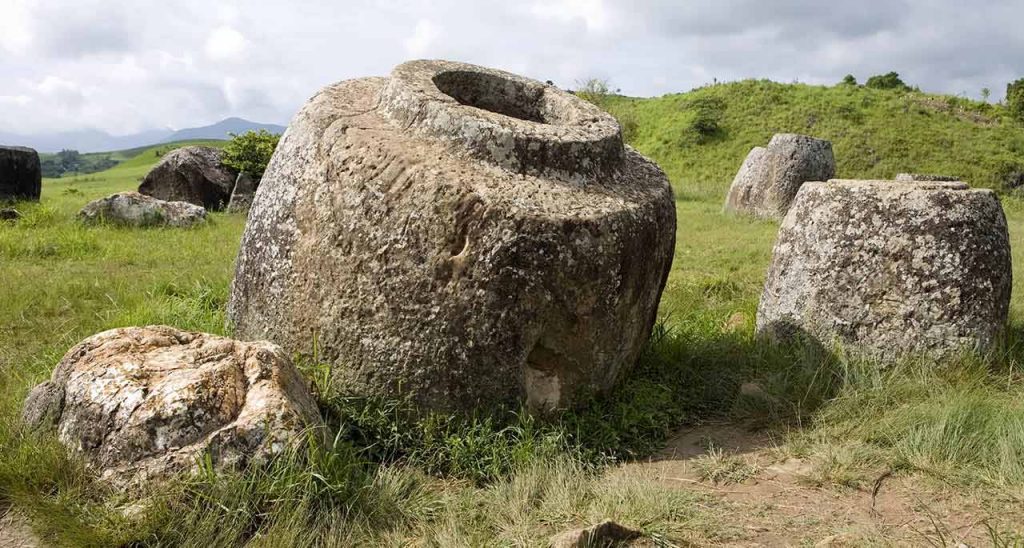
PHOTO: remotelands.com
XIANGKHOANG PLATEAU, LAOS – in the upland valleys and lower foothills of the Xiangkhoang Plateau, there lies a fascinating landscape dotted with megalithic ‘jars’. Over 90 jar sites have been discovered in this area. Some sites contain just one jar. Others contain over four hundred. Researchers believe that the stone jars at Site 1 are over 2,500 years old, dating all the way back to the Iron Age.
Not much is known about why these huge jars were hewn out of sandstone and scattered throughout the plateau and surrounding foothills. We’re not even sure who made them in the first place. Archaeologists do have a theory that the Iron Age peoples who carved the megalithic jars used them to expose their dead relatives to the elements before burial. They’ve discovered dozens of people buried in individual and communal graves scattered around some of the largest megaliths.
Unfortunately, not much fieldwork can be done on the area. The Plain of Jars was the site of bitter fighting during the Vietnam War. It’s littered with an estimated 80 million undetonated bombs that were dropped by American warplanes during the Vietnam War. The Laos government is making an effort to clear the area, but currently it’s far too dangerous for any traditional archaeological fieldwork to be done on the jars.

PHOTO: Britannica
“We certainly can’t just go and put shovels into the ground!” – Louise Shewan, archaeologist at Monash University and Plain of Jars Project Co-Leader.
Modern Archaeology To the Rescue
Thanks to modern archaeology and new advancements in virtual reality, research on the Plain of Jars isn’t going to be stopped by some 80 million undetonated bombs.
A collaborative virtual reality project between several groups of archaeologists and researchers from Monash University in Melbourne, Australia, is using drones to record aerial footage of the archaeological excavations done at “Site 1” of the Plain of Jars and footage of harder-to-reach, bomb-littered parts of the Plain of Jars. The project is going to virtually recreate the unique landscape, complete with the megalithic stone jars. All of the footage, images, and data taken by the remote drones has been input into a 3D video that can be viewed in a 360-degree virtual-reality facility at Monash University in Melbourne, Australia. The virtual-reality room is being dubbed ‘Cave2’.
“We can fly the drones through [Site 1 and Site 2], and put all that information and imagery into the Cave2 and make comparisons such as, is there a consistent placement between the jars, or between different types of burial markers?” Shewan explained. “Long after we leave the field, we can continue researching, and we can actually be there with all our team members and go through the excavation again, and pick up on things that we’ve missed.”
Not only that, but the team is hoping to open Cave2 up to classes in archaeology and anthropology so students can see real archaeological fieldwork in 3D virtual reality. The end goal is to hopefully record the entire Plain of Jars and open it up to the public in a museum exhibition. The Cave2 simulation is also being used as evidence to keep the Plain of Jars in Laos designated as a UNESCO World Heritage Site. This designation will help encourage interest in the site and spur further scientific research and funding to help clear the Plain of Jars from bombs and make it safe to excavate.
For now, though, the Plain of Jars is only available through the Cave2 facility at Monash University.
Louise Shewan is continuing her research on the burials discovered around some jars, though. She’s teaming up with ANU geochemist Richard Armstrong to figure out the geographical origin and of some of the jars found at Site 1. They’re hoping this will give them some clues about who made the jars.
The Plain of Jars in Laos remains a site shrouded in mystery, but thanks to its UNESCO World Heritage Site designation and the new Cave2 project, it’s becoming a little less mysterious day by day.

